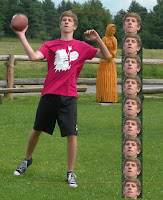The ratio of a Golden Rectangle's sides is φ (phi = 1.6180339887...), an irrational number, similar to π (pi = 3.14159...). φ is often called the Golden Mean or Golden Ratio. By repeating this process, you can create a lovely spiral:
The golden ratio has been used to
create ideal canvas proportions, and to choose where to place elements in a
composition. For this lesson, our concern is canvas shape. Some artists and
historians claim that this "divine proportion" has been used by the
greatest artists in history, from ancient Egypt and Greece to Da Vinci,
Michelangelo, Rembrandt, Turner, and Manet.
They say you can also find examples in nature, especially seashells.
Note, the bottom line doesn't touch the ground or the top of the platform,
so the rectangle doesn't really fit.
They say you can also find examples in nature, especially seashells.
Note, the black line doesn't really follow the line of the shell. It's a different proportion.
On the internet, you can find many
examples of this spiral superimposed on artworks, often in complicated,
confusing ways.
It's described as a secret to making great art, like a magic bullet, that all the masters knew and used––something to excite beginning artists.
It's described as a secret to making great art, like a magic bullet, that all the masters knew and used––something to excite beginning artists.
Here's the problem––it's
debatable, and many professional artists, for example James Gurney, call it a
myth. It's easy to superimpose these diagrams in any picture, but it doesn't
prove the artists/architects actually used them in their planning, nor does it
prove that it makes the art better.
Putting these spirals over artwork is easy, partly because of pareidolia - a psychological phenomenon where people perceive things that aren't really there. No, not like schizophrenia––this isn't about hearing voices. This is more like seeing shapes in clouds, or playing a song backwards, and hearing words. Our brain wants to understand what it sees, so it will sometimes see a pattern that isn't there, or was unintentional.
The golden ratio is only part of
the debate in the importance of geometry in canvas shape, because supporters
say there is more than one divine proportion. Artist and teacher Myron
Barnstone describes a series of "root" rectangles, which are all
related to a square, even though none represents the golden ratio:
With so many choices, it's easy to
find a rectangle and a diagram that will fit any artwork, even if that artist
never thought of it. So, how many artists have actually used any of this? And,
how important is it? Is it necessary? Is it useful? Good questions. First,
let's see what James Gurney has to say:
"If the golden rectangle
(1.618:1) really was the ideal shape, why didn't it appear everywhere in our
carefully designed environment? Why don't we find it in the proportions of
movie screens (1.37:1, 1.85:1, 2.35:1), photographs (1.50:1) television
monitors, (1.33:1, 1.78:1) computer screens (1.33:1, 1.60:1, 1.78:1), credit
cards (1.5858:1), not to mention iPhones, tablets, and office paper? Those
rectangles, each so commonplace in our daily lives, vary greatly, and none of
them quite matches the supposed ideal.
Perhaps there's a deeper aesthetic
truth to be gleaned from all of this. A masterpiece, it turns out, does not
issue from fixed mathematical rules. It comes from a happy mixture of all the
elements of composition cohering with messy particularity. For one painting, a
3x4 rectangle might be the ideal choice; for another, a square might yield
divine results. The picture's central idea must drive the decision. Just as
there is no optimum running length for a film, no optimum key for a symphony,
and no optimum structure for a poem, there's no optimum shape for a
painting."
Now, let's bring the question to Stapleton Kearns, a practicing fine artist:
"I suggest that you paint only about six different
sizes and stick to stock sizes when you paint. The advantage of stock or common
sizes is that you don't necessarily have to have all of your frames custom
made, but can instead buy them off the rack. Here are some of the most common
stock sizes for frames.
Here are the smaller sizes; The most common middle sizes are; The larger sizes are;
5 x 7 16 x 20 24 x 30
8 x 10 18 x 24 24 x 36
9 x 12 20 x 24 30 x 40
11 x 14
12 x 16
If you choose two sizes from each of these categories, one
elongated and one more square, you will have six sizes. You should be able to
find premade frames for those sizes from almost any supplier. If you want to
have custom frames made, by which I mean closed corner 22k. gold frames, you
will be happy to be able to put the picture into a ready made frame. That's a
good thing for when you send it to a show or gallery where you know your
paintings will be stacked by tongue swallowing interns . . . You will save a
lot of headaches by limiting yourself to six sizes. Having interchangeable
framing is real handy . . . I make between 40 and 70 paintings a year, I throw
about a third as many more away unfinished because they have some sort of an
irredeemable flaw. So, if I paint too many sizes, it really gets complicated and
expensive having many dedicated frames that only fit one painting."
Notice, that Mr. Kearns didn't mention the golden ratio once. All his advice is practical and economical, and none of the standard sizes above represents the golden ratio, although a 5" x 7" canvas is a root 2 rectangle. None of the others is root anything. So, there's the difference between the theory of an art school and the reality of a working, professional artist.












































.jpg)





